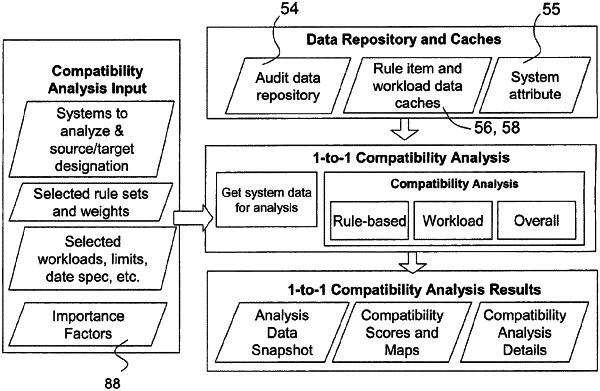| CPC G06Q 10/06 (2013.01) |

| AS A RESULT OF REEXAMINATION, IT HAS BEEN DETERMINED THAT: |
| The patentability of claims 3, 6 and 7 is confirmed. |
| New claims 19-32 are added and determined to be patentable. |
| Claims 1, 2, 4, 5 and 8-18 were not reexamined. |
|
3. A method for performing a virtual to virtual (V2V) transformation for a plurality of existing virtual guests and hosts, said method comprising:
analyzing said existing virtual guests and hosts based on technical, business and workload constraints by evaluating each virtual guest against each virtual host and other virtual guests using one or more rule sets pertaining to said technical, business and workload constraints to determine guest-host placements;
based on said analyzing, determining which of said existing virtual servers are most suitable for conversion from one virtualized platform to another virtualized platform; and
providing a mapping from said one platform to said another platform to facilitate said transformation.
|
|
[ 19. The method of claim 6, wherein said workload requirements are determined based on a subset of the workload data gathered in the step of obtaining a set of virtualization guest candidates and determining aggregate workload requirements based on workload data pertaining to said guest candidates.]
|
|
[ 20. The method of claim 19, wherein the subset of data used to determine said workload requirements is based on the statistical quantiles of the daily utilization levels of workload data gathered.]
|
|
[ 21. The method of claim 19, wherein the said workload requirements are determined based on the day whose average utilization is the highest of all of the days of workload data that are included in said subset of data.]
|
|
[ 22. The method of claim 19, wherein the said workload requirements are determined based on the day whose average utilization is the statistical mean of all of the days of workload data that are included in said subset of data.]
|
|
[ 23. The method of claim 19, wherein the said workload requirements are determined based on a temporal extrapolation of the trends in the workload data that is included in said subset of data.]
|
|
[ 24. The method of claim 19, wherein the subset of data used to determine said workload requirements is based on the days of data gathered whose day of the month matches the current day of the month at the time of analysis.]
|
|
[ 25. The method of claim 24, wherein the day of the month used to match the days of data gathered is the current day of the month at the time of analysis plus a fixed number of days into the future.]
|
|
[ 26. The method of claim 19, wherein the subset of data used to determine said workload requirements is based on the days of data gathered whose day of the week matches the current day of the week at the time of analysis.]
|
|
[ 27. The method of claim 26, wherein the day of the week used to match the days of data gathered is the current day of the week at the time of analysis plus a fixed number of days into the future.]
|
|
[ 28. The method of claim 19, wherein the determining aggregate workload requirements employs benchmark values to normalize the CPU utilization data to account for the performance differences of varying processor architectures.]
|
|
[ 29. The method of claim 28, wherein the benchmark value is determined based on the server model, processors, or type or workload running in each of the virtualization guest candidates.]
|
|
[ 30. The method of claim 19, wherein the determining aggregate workload requirements includes adding a virtualization overhead to the CPU and Memory utilization of each of the virtualization guest candidates.]
|
|
[ 31. The method of claim 30, wherein the CPU overhead for a virtualization guest candidate is a function of that candidate's CPU utilization, network VO and disk VO rates.]
|
|
[ 32. The method of claim 30, wherein the Memory overhead for a virtualization guest candidate is a function of that candidate's memory allocation, the number of virtual CPUs, and whether it is running a 32 or 64 bit operating system.]
|